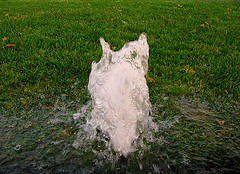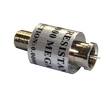 Recognizing a water leaks within a sprinkler zone can be difficult as they may not reveal their location until under pressure.
Recognizing a water leaks within a sprinkler zone can be difficult as they may not reveal their location until under pressure.
How do you recognize a minor leak in the sprinkler zone if it’s not obvious?
- The first noticeable trait would be the zone does not appear to cover the ground as well as it used to. You may also recognize plant material or turf that appears dry or starving for water.
- Moist mucky dirt, soggy spongy area(s) in the yard. Someplace that never seems to be dry.
- New or additional brown patches in the turf indicating low water coverage.
If you have read any of my sprinkler articles you know that most sprinkler problems are with heads and valves. Both provide obvious indicators of water loss. Here is a recap of the most common problems:
- Weeping heads: A slight amount of water is passing through the valve when it should be closed. The sprinkler heads remain wet well after the sprinklers have run. Typically, disassembling the valve and cleaning will correct it.
- Dirty heads: Dirt, pebbles and grunge can lodge itself in the sprinkler nozzle as well as the body and shaft of the sprinkler head. These problems will modifiy the pattern, providing excessive water in the wrong places. Start by replacing or disassembling the head and cleaning it. TIP: Like for like heads and nozzles will reduce complications in future repairs. When a sprinkler zone is turned off, typically the lowest head in the zone becomes the relief valve causing water left in the lines to drain out. This is very normal. However, in doing so, a suction is created that can pull in surface water, and dirt from around the other heads. This dirt can migrate throughout the zone clogging the other heads. TIP: If the location of the low head is in a bad place, an in-line drain can be installed in the pipe, but you will have to dig up the pipe to do it.
- Broken head: Obvious water spray outside the defined pattern. This can be corrected by replacing the head or the broken parts. TIP: Keep extra sprinkler heads to replace bad ones. Rebuild the old ones if you can. Remember to reuse or replace the nozzle like for like. Many times you can replace the entire head without disturbing the surrounding dirt. This reduces the opportunity of allowing new dirt into the system and keep you from having to to dig the head up.
- Lawn butchers: Weed Eaters and edgers are the death of lawn sprinklers. They can easily destroy several heads over a season of mowing.
- Allowing dirt in the system: No different than the water system in your house, allowing dirt in the pipes creates opportunities to clog valves and heads, creating more work for you. When working on sprinkler heads and valves avoid this by taking the appropriate steps to stop surface water back into the system. When you run a zone and identify a head that needs attention, removing the head may create a suction that will pull water and dirt into the pipes. Admittedly more work, by digging up the dirt from around the head and getting the hole deeper than the head connection can reduce the opportunitiy of allowing dirty water into the sprinkler system. TIP: If there is no standing water at the head, attempt to change it without digging it up as described in number #3, this will save you some time.
If you have corrected the problems associated with the above list and you still have problems, its time to look deeper into the system. Most likely, if you have gone this far you are recognizing that a specific zone does not present the same pressure, or cover its area as well as the others. This trait is an indication of a pipe, joint or fitting leak, and the leak is large enough to reduce the zone pressure but not enough to create a pool or hole in the lawn.
 Try this method to further isolate the leak:
Try this method to further isolate the leak:
- Assuming you have pop-up type heads, adjust the screw on the top of the nozzle (on every head in the active zone) to shut off the water on that head(s) TOTALLY. This increased pressure may be enough to cause the small leak to burst. Continue to walk the sprinkler zone looking for mushy ground and water pools. Also, go look at your water meter for measured water usage. Look for the meter to be moving at a medium to rapid pace (make sure everything in the house is turned off). TIP: Since lawn sprinkler heads are not rated to hold full pressure like a faucet, some small degree of water oozing is acceptable.
- If you have other styles of heads or #1 didn’t find it, this step #2 will be dirty wet work. Conceptually, it’s the same as #1 but requires you to expose each and every head on the zone and install a threaded cap to replace each sprinkler. In this method, you have to remove all the heads from the equation and the zone should hold pressure just like any pressurized plumbing line. Check the water meter; if you still see a water loss, leave the zone on for 2 or 3 hours, or even the whole day. Again, look for water pools or mushy ground and check your meter.
You may also find benefit in reading the other articles I have written on the subject: Lawn Sprinkler Efficiency Part II, Lawn Sprinkler Efficiency Part I , Searching for Lawn Sprinkler Valves, Chasing Lawn Sprinkler Leaks



 Posted by homeownerbob
Posted by homeownerbob 


